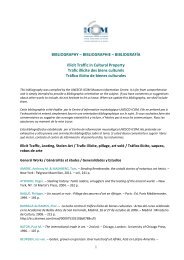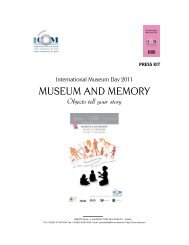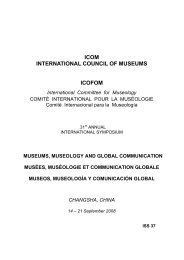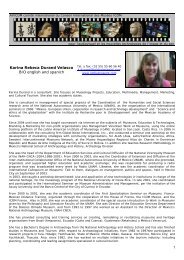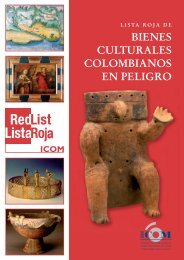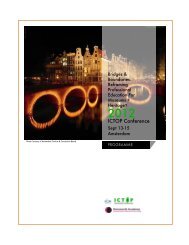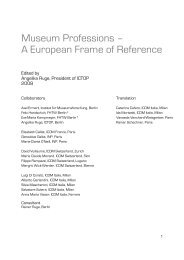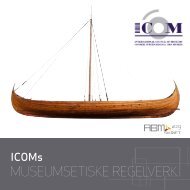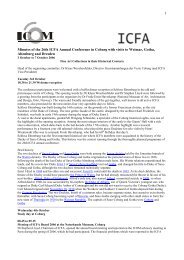Key Concepts of Museology - ICOM
Key Concepts of Museology - ICOM
Key Concepts of Museology - ICOM
You also want an ePaper? Increase the reach of your titles
YUMPU automatically turns print PDFs into web optimized ePapers that Google loves.
<strong>of</strong> being in the median position, that<br />
<strong>of</strong> a third element which places itself<br />
between two distant poles and acts<br />
as an intermediary. While this position<br />
characterises the legal aspects <strong>of</strong><br />
mediation, where someone negotiates<br />
in order to reconcile adversaries and<br />
reach a modus vivendi, it also points<br />
to the meaning that this concept<br />
takes in the cultural and scientifi c fi e<br />
ld <strong>of</strong> museology. Here too mediation<br />
is an in-between, fi lling a space that it<br />
will try to reduce, creating a connection<br />
or even acceptance.<br />
1. The notion <strong>of</strong> mediation works<br />
on several levels: on the philosophical<br />
level it served Hegel and his disciples<br />
to describe the movement <strong>of</strong> history<br />
itself. Dialectics, the driving force<br />
<strong>of</strong> history, advances by successive<br />
mediations: a fi rst situation (the thesis)<br />
must pass through the mediation<br />
<strong>of</strong> its opposite (antithesis) to progress<br />
to a new condition (synthesis) which<br />
retains something <strong>of</strong> each <strong>of</strong> the two<br />
preceding moments.<br />
The general concept <strong>of</strong> mediation<br />
also leads us to think about<br />
the institution <strong>of</strong> culture itself as<br />
the transmission <strong>of</strong> that common<br />
heritage which unites the members<br />
<strong>of</strong> a community and in which they<br />
recognise themselves. In this sense<br />
<strong>of</strong> the word mediation, it is through<br />
the mediation <strong>of</strong> its culture that individuals<br />
perceive and understand the<br />
world and their own identity; several<br />
writers speak <strong>of</strong> symbolic mediation.<br />
Again in the cultural fi eld, mediation<br />
acts to analyse the ‘making public’ <strong>of</strong><br />
ideas and cultural products – their<br />
being taken care <strong>of</strong> by the media<br />
– and to describe their circulation<br />
in the whole social sphere. The<br />
cultural sphere is seen as a dynamic,<br />
nebulous area where products mix<br />
together and take over from one another.<br />
Here the reciprocal mediation<br />
<strong>of</strong> cultural products leads to the idea<br />
<strong>of</strong> intermediality, <strong>of</strong> the relationship<br />
between medias and the way in which<br />
one media – television or cinema for<br />
example – translates forms <strong>of</strong> production<br />
made in another media (a<br />
novel adapted for the cinema). These<br />
creations reach their targets by one<br />
or other <strong>of</strong> the various technical aids<br />
that make up their mediatisation.<br />
From this angle, analysis shows that<br />
many mediations are set in motion by<br />
complex chains <strong>of</strong> different agents<br />
to guarantee content in the cultural<br />
sphere and ensure that this content<br />
reaches a broad public.<br />
2. In museology the term mediation<br />
has been in frequent use in<br />
France and in European Frenchspeaking<br />
zones for more than a<br />
decade, when speaking <strong>of</strong> ‘cultural<br />
mediation’, or ‘scientifi c mediation’<br />
and ‘mediator’. Essentially it refers<br />
to a whole range <strong>of</strong> actions carried<br />
out in a museal context in order to<br />
build bridges between that which<br />
is exhibited (seeing) and the meanings<br />
that these objects and sites may<br />
carry (knowledge). Mediation sometimes<br />
seeks to favour the sharing <strong>of</strong><br />
experiences and social interactions<br />
between visitors, and the emergence<br />
<strong>of</strong> common references. This is an<br />
educational communication strategy,<br />
47



